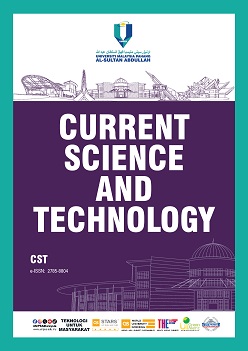Feasibility of Biodiesel Production from Patty Oil Waste via the Transesterification
DOI:
https://doi.org/10.15282/cst.v4i1.11561Keywords:
Transesterification, Patty oil waste, BiodieselAbstract
Patty oil waste poses significant environmental risks, including land contamination, water pollution, and detrimental effects on plant and animal life if not managed appropriately. To address this issue, the transesterification process offers a sustainable solution for converting patty oil waste into biodiesel, an eco-friendly alternative fuel. This study aims to optimize biodiesel production from patty oil waste using a two-step transesterification process, evaluating its physical and chemical properties. The solid-phase patty oil waste was pretreated and processed using potassium hydroxide (KOH) as a homogeneous catalyst. The initial free fatty acid (FFA) content of the patty oil waste was 6.175%, exceeding the acceptable 5% threshold for direct transesterification. After esterification, the FFA content was reduced to 1.238%, meeting the required specifications. Biodiesel properties were characterized using thin-layer chromatography (TLC) and gas chromatography-mass spectrometry (GC-MS), confirming high methyl ester conversion. The optimal reaction conditions were determined as a KOH concentration of 1.5 wt%, a reaction time of 90 minutes, and a methanol-to-oil molar ratio of 6:1, yielding a maximum methyl ester conversion of 88.47%. The produced biodiesel exhibited properties in compliance with ASTM D6571 standards, including a density of 854 kg/m³, iodine value of 81.24 g/100 g, and acid value of 0.0314 mg KOH/g. This study highlights the potential of patty oil waste as a feedstock for biodiesel production and underscores the efficacy of RSM in optimizing the transesterification process for high-quality biodiesel yield.
References
[1] A. S. Elgharbawy, W. Sadik, O. M. Sadek and M. A. Kasaby, “A review on biodiesel feedstocks and production technologies,”. Journal of the Chilean Chemical Society, vol. 66, no. 1, pp. 5098-5109, 2021.
[2] N. A. Hamdi, S. Sha'Arani, N. F. Azman, S. B. M. Rafi, E. Norsin and N. Othman, “Management of waste cooking oil and its potential for value-added materials: A mini review,” In IOP Conference Series: Earth and Environmental Science, vol. 1091, no. 1, p. 012054, 2022
[3] M. C. Hsiao, P. H. Liao, N. V. Lan and S. S. Hou, “Enhancement of biodiesel production from high-acid-value waste cooking oil via a microwave reactor using a homogeneous alkaline catalyst,” Energies, vol. 14, no. 2, p. 437, 2021.
[4] Z. Weng, Y. Tao, H. Fei, W. Deng, Y. Chen, Z. Zhao, et al., “Green production of biodiesel from high acid value oil via glycerol esterification and transesterification catalyzed by nano hydrated eggshell-derived CaO,” Energies, vol. 16, no. 18, p. 6717, 2023.
[5] G. P. Maniam, H. S. Lim and N. M. Hussin, “Effect of free fatty acid on transesterification of waste cooking oil,” Current Science and Technology, vol. 3, no. 1, pp. 57-63, 2023.
[6] Y. Huang, F. Li, G. Bao, M. Li and H. Wang, “Qualitative and quantitative analysis of the influence of biodiesel fatty acid methyl esters on iodine value,” Environmental Science and Pollution Research, vol. 29, no. 2, pp. 2432-2447, 2022.
[7] D. Unlu, N. Boz, O. Ilgen and N. Hilmioglu, “Improvement of fuel properties of biodiesel with bio additive ethyl levulinate,” Open Chemistry, vol. 16, no. 1, pp. 647-652, 2018.
Downloads
Published
Issue
Section
License
Copyright (c) 2024 The Author(s)

This work is licensed under a Creative Commons Attribution-NonCommercial 4.0 International License.



